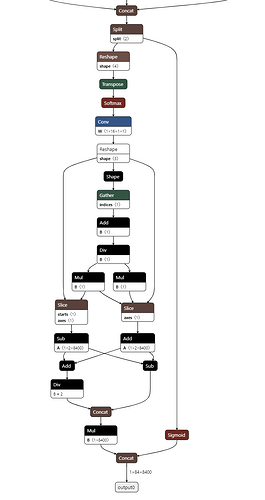Which system do you use? Android, Ubuntu, OOWOW or others?
Ubuntu
Which version of system do you use? Khadas official images, self built images, or others?
Khadas Official Image from OOWOW
Linux Khadas 5.10.160 #1.6.2
Please describe your issue below:
The outputs from inferencing YOLOv8n POSE have some deficiencies, the output format is 8600 rows of 56 attributes, the first 4 for a bounding box, the next a confidence, then 17 keypoints (2 spatial and a confidence value). This is similar to the YOLOv8 detect output which is the 4 bounding box attributes and then the rest are the confidence for all the classes. The output I get is completely 0.00 for all of the confidence values and bounding boxes and has concerning rows and columns of 0.00 that are unexpected (these may correspond to keypoint confidence). Here are some example row outputs.
[ 0. 0. 0. 0. 0. 227.57094
7.7581 0. 230.15697 5.1720667 0. 224.9849
5.1720667 0. 232.743 0. 0. 222.39886
2.5860333 0. 235.32904 5.1720667 0. 217.2268
5.1720667 0. 237.91507 18.102234 0. 214.64076
18.102234 0. 230.15697 20.688267 0. 219.81284
20.688267 0. 232.743 20.688267 0. 222.39886
20.688267 0. 232.743 10.344133 0. 222.39886
10.344133 0. 232.743 23.2743 0. 224.9849
23.2743 0. ]
> /home/khadas/pose_perf/yolo_test.py(363)<module>()
-> for row in range(out.shape[0]):
(Pdb) c
[ 0. 0. 0. 0. 0. 237.91507
7.7581 0. 240.5011 5.1720667 0. 235.32904
5.1720667 0. 240.5011 0. 0. 230.15697
2.5860333 0. 245.67317 5.1720667 0. 227.57094
5.1720667 0. 248.2592 18.102234 0. 224.9849
18.102234 0. 240.5011 20.688267 0. 230.15697
20.688267 0. 243.08713 20.688267 0. 232.743
20.688267 0. 243.08713 10.344133 0. 230.15697
10.344133 0. 243.08713 23.2743 0. 235.32904
23.2743 0. ]
Here is an example of what this output should look like, even though the confidence values for the row are low, the bounding box coordinates are not near zero.
(Pdb) p np_out[0]
array([ 12.353, 16.379, 36.39, 46.78, 4.5582e-06, 4.6046, -8.2559, 0.14382, 4.6362, -9.6881, 0.12751, 4.0202, -9.5472, 0.12229, 2.6991, -8.9242, 0.23624, 5.5221, -8.7413, 0.22851, 3.0457, -3.6397, 0.37018, 5.138,
-3.5511, 0.36872, 4.2668, -1.6557, 0.18525, 4.4674, -1.5006, 0.18891, 3.7493, -0.1979, 0.15563, 5.2914, -0.15677, 0.16213, 4.0072, 5.2005, 0.21152, 5.5032, 5.3291, 0.21354, 4.6373, 8.0499, 0.1262, 4.2513,
8.4074, 0.12954, 5.0615, 14.274, 0.1409, 4.5339, 14.378, 0.14318], dtype=float32)
My inference results with the YOLOv8 detect model are as expected and don’t have conspicuous zero rows.
